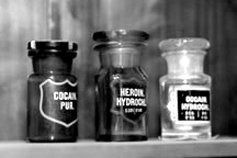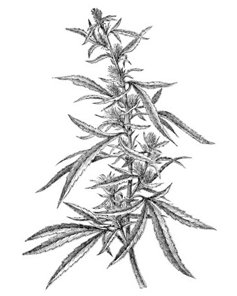Twentieth Century Marijuana

In the early Twentieth Century, cannabis began to attract attention from legislative bodies. Taxes and laws began to be enacted against the cultivation of industrial cannabis or the use of marijuana as an intoxicant or ingredient in medications.
One of the first laws was the Pure Food and Drug Act of 1906 that required that the contents of patent medicines be revealed. So the inclusion of morphine, alcohol, cocaine, heroin or cannabis had to be listed on the label, along with the quantity of the drug. It was not illegal to sell these medications over the counter—the law only required that the ingredients be revealed as many of these concoctions had previously kept their contents a secret.
By 1914, opium addiction was a widespread problem in the US, with an estimated one in every 400 people being addicted. Many women became addicted after being given opium as medication for menstrual or emotional problems. Many men had become addicted to another opiate, morphine, after the Civil War since this was the painkiller available for those who had become injured. The Harrison Narcotics Act of December 1914 imposed controls and taxes on the distribution of opiates or cocaine. This was one of the earliest curbs on the trafficking of addictive drugs in the US. It was shortly followed by the prohibition of alcohol production and sale, a ban that was repealed in 1933.
Various attempts to create federal bans on marijuana use followed these efforts but failed.
One by one, states began to pass their own laws against marijuana sales and consumption:
- 1915 California, Utah, Wyoming
- 1919 Texas
- 1923 Iowa, Nevada, Oregon, Washington, Arkansas
- 1927 Nebraska
Northern states like Maine, Vermont, Massachusetts and New York considered cannabis a narcotic along with opium, morphine, heroin, and codeine and had already outlawed its use without a doctor’s prescription.

Despite these controls, marijuana became more popular and use spread to the Southwestern US, New Orleans, and the New York area. The core users in each area were the ethnic groups who had moved into those areas in search of work or a good time: jazz musicians in New Orleans, Mexican laborers, and African-Americans who left the South to find jobs in the big city. The association of marijuana use with ethnic groups aggravated the antagonism of lawmakers who were generally affluent and Caucasian.
In the early 1930s, jazz and swing musicians published a number of songs that featured marijuana, such as Cab Calloway’s “That Funny Reefer Man” and Benny Goodman’s “Sweet Marihuana Brown.”
In 1930, the Federal Bureau of Narcotics was founded, with Harry Anslinger as its director. Anslinger undertook to outlaw the use of cannabis by spreading stories of murder and rampant insanity among those who used the drug. By 1937, he had succeeded in getting the Marijuana Tax Act passed which criminalized the use of cannabis unless proper taxes were paid. This law suppressed the use of hemp for cloth or rope.
However, during World War II, hemp was needed for parachutes, cordage and other military supplies. American farmers were given incentives to grow hemp for the war effort.
Between 1952 and 1956, two laws were passed that brought America into its current philosophy of outlawing addictive drugs and arresting drug users. The first was the Boggs Act and the second was the Narcotics Control Act of 1956. First-time possession of marijuana could receive a sentence of two to ten years in prison.
There may have been well-meaning intentions behind these laws but they failed to stop the growth in marijuana use that was just around the corner.
More Marijuana Information:
Marijuana Information | Marijuana Addiction
Resources:
 ®
®